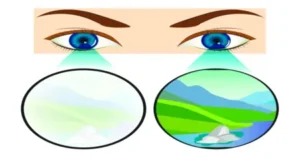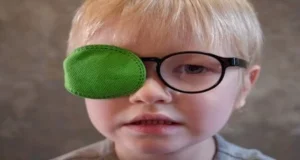Does having lazy eyes affect brain function?
What is Amblyopia?
Although you’ve heard the word before, many parents are unaware of the actual nature of Amblyopia. You need to have a basic understanding of vision in order to comprehend the issue.
Nothing is actually “seen” by our eyes. Instead, they communicate impulses and information to the brain, which then converts them into what we “see” with our eyes. Although it requires a strong connection between the eyes and the brain, this remarkable mechanism operates without a problem.
Oftentimes, one eye has a stronger connection than the other. This causes the weaker eye to focus less than the stronger eye, making it appear to wander more.
The term “Amblyopia” was used to describe this lack of focus. If mistreated, the brain may eventually ignore all signals from the weaker eye, thus diminishing your child’s vision in that eye.

What are the causes of Amblyopia?
Throughout the crucial period, both eyes must get crystal-clear images. Amblyopia can develop if there is anything that prevents either eye from seeing clearly between birth and the age of six (a reduction in vision not corrected by glasses or elimination of an eye turn).
The most common causes of amblyopia are anisometropia (different glasses prescriptions in each eye), continual strabismus (constant turning of one eye towards the nose or outside), and/or blocking of an eye as a result of trauma, lid droop, etc.
The visual cortex of the brain will inhibit (block, suppress, or ignore) the blurry eye if one eye sees well while the other sees a haze. Amblyopia is a neurologically active condition. The inhibition process (suppression) can cause a permanent decline in vision in that eye, which cannot be treated with LASIK surgery, glasses, or lenses.
How does Amblyopia affect the brain?
Research has demonstrated that during development, the brain forms new connections between brain cells and strengthens existing ones in a process known as neuroplasticity.
Amblyopia, which affects 1-3 percent of the population, is the most common neurological vision problem in children and adults. Children with impaired eyesight are more likely to experience impairment in cognitive skills related to things like attention.
Amblyopia’s effects on eyesight
The images each eye normally transmits to the brain are identical. The brain learns to disregard the subpar image sent by one eye and “sees” exclusively with the healthy eye when their differences are too great. The ignored eye’s eyesight deteriorates as a result of inactivity.

Amblyopia treatment
Amblyopia treatment is far more effective if it begins in childhood when the interconnections between the brain and the eyes are still forming. Strategies emphasise getting the child’s brain to use the less-effective eye. Options consist of:

Eye patches for children: Kids can cover the better eye with a patch for at least a few hours each day. This is a common Amblyopia treatment and may continue for months or years. The weaker eye gradually becomes stronger due to the patch’s pressure on the brain to process images from that eye.
Glasses: Another typical lazy eye treatment is wearing a pair of glasses. By reducing nearsightedness, farsightedness, and eye crossing, glasses can aid in treating amblyopia.
Surgery: Amblyopia operations are uncommon. Your doctor may advise surgery to treat some amblyopia-related conditions, such as crossed eyes or cataracts.
Eye drops: To temporarily blur the vision in the better eye in moderate cases, your doctor may advise using eye drops (atropine). The objective is the same as with a patch: to make the brain utilise the less-effective eye.
Why choose Bynocs for expert consultation?
Dealing with Amblyopia can be a challenge and must be dealt with by an expert. Bynocs is a renowned clinic known to offer reliable consultations and solutions.
Bynocs is a newly developed cloud-based program that has been specifically intended to manage Amblyopia, Computer Vision Syndrome, and a quicker neuroadaptation.

